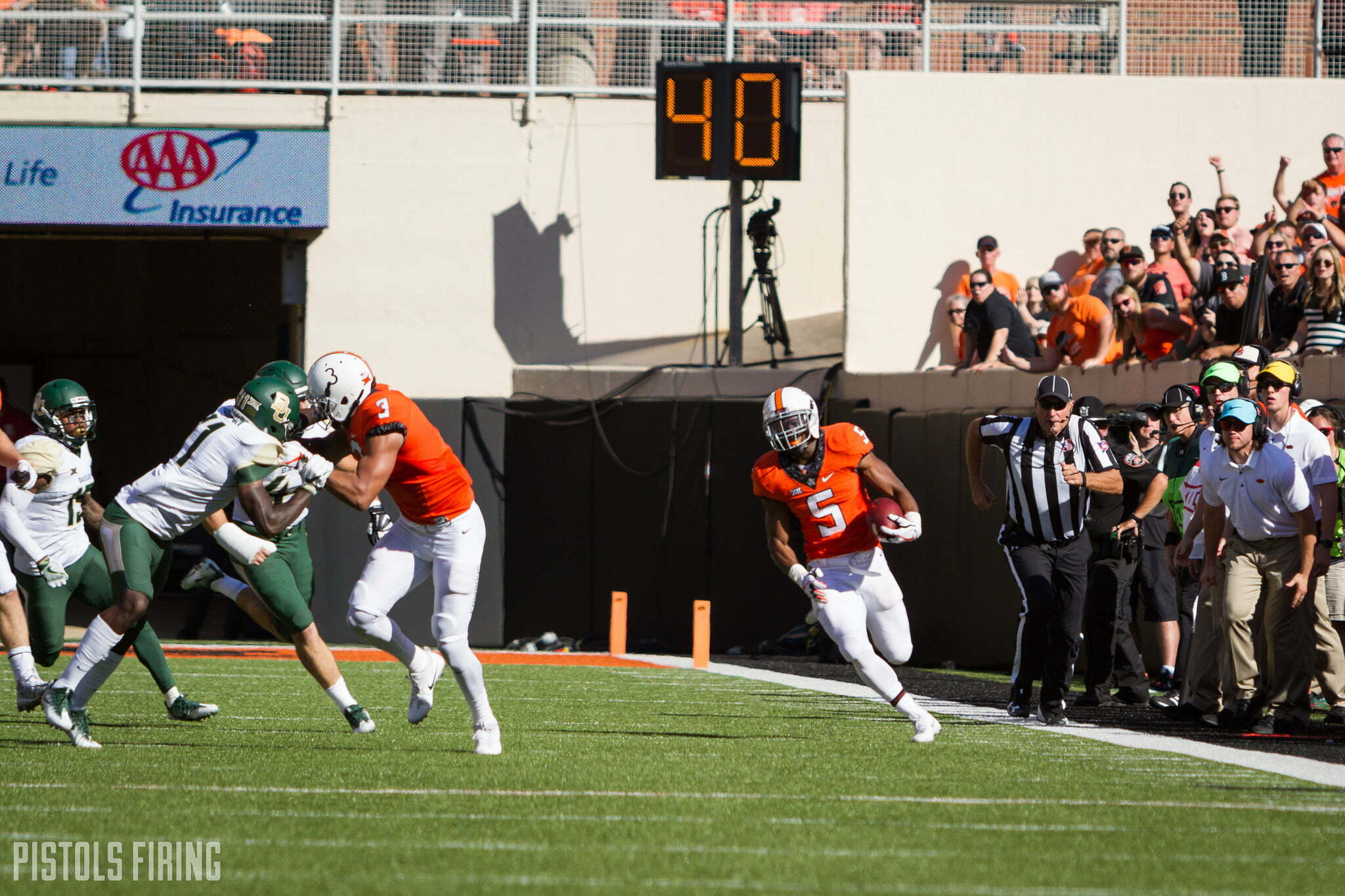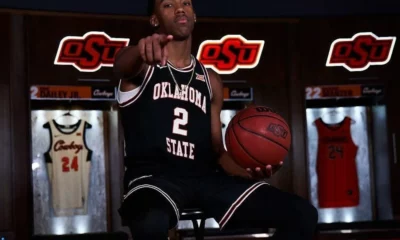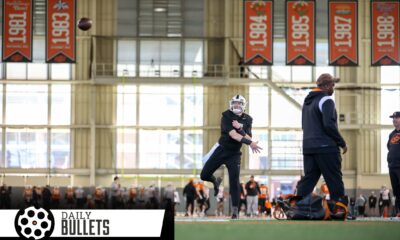Football
The Play That Disrupted the Big 12 and the Evolution of the Oklahoma State Offense

Fifty-seven. That’s the number of times Oklahoma State ran the play that transformed their offense into what it was in 2017. This number really could be closer to 200, but given the nature of this article, it makes more sense to keep the scope smaller.
Mike Yurcich’s offensive style makes analysis like this difficult. His playbook is all about simplicity in that he adds more complimentary pieces to existing base plays whereas traditional coaching states you should just create new plays altogether. This is where the lines get blurry, because there are many variations of the same play repeatedly.
Why is this play important?
Outside of the play being the foundation of the Oklahoma State RPO game, it was also extremely successful. This play in its base version accounted for 698 yards and 7 Touchdowns in 2017, including James Washington’s long touchdowns against South Alabama, Baylor and the opening score against Texas Tech. It also created the foundation for the evolution of the offense down the stretch of the season. More on this later.
Enough of the intro, what is the play already?
This play is the base concept for about half of the RPOs that Oklahoma State ran. It’s ran primarily in 11 personnel (1 RB, 1 TE), although I did find three instances where it was ran out of 10 personnel (1 RB, 4 WR). The idea is to package a slant (Z) with a bubble screen (Y – slot) on one side, and the other side there is an option route where the receiver (X) can run a slant, go route or just become a blocker depending on the play design and coverage shown. Of the 57 times it was run, there were 26 passing plays and 31 run plays which only added to its success rate with a high level of unpredictability.
Here is the play in a few different formats, with both run and pass examples.
1. Pass play – pull ball on RPO: One thing to note here, Keenen Brown is out wide at the X position which is not normal, usually this was Marcell Ateman. On the play before this they were in a big set, 12 personnel set and ran hurry up. Given the fact that this play isn’t really designed for the backside X receiver, you can run hurry up without substitution easily. Add this to one of the many reasons why this play is great.
Here is the same action, but with a better view to give you look at bubble/slant combo pre-snap.
2. Run play – hand ball off on RPO: Notice here that Marcell Ateman immediately starts blocking off the snap, and does an incredible job continuing to block downfield. If he feels run, he can break off his route and start to run block.
3. With 10 personnel – same concept but in trips: Notice the same slant/bubble action, but this time there is an inside WR running a vertical route. The defense is totally lost on the RPO action paired with the added vertical route, and Dillon Stoner runs free for an easy touchdown.
Defensive adjustments
Admittedly, this play started to wear down as the season progressed, as defenses started to adjust and scheme specifically for it. It’s also worth noting that the matchups weren’t as advantageous later in the season. After Texas laid down the blueprint to force Oklahoma State into uncomfortable situations, the effectiveness of this play deteriorated.
The last five games of the season, Oklahoma State saw more three-man fronts than they did in the first half of the season, which made it more challenging to incorporate this play into the game plan. Instead of linebackers and nickelbacks crashing on the run fakes, there were more safeties filling run gaps which left passing lanes in the middle of the field covered. That didn’t stop Yurcich and the offensive staff from utilizing it as a strength though.
Strategy
The whole foundation of the Oklahoma State offense is creating base plays to keep things simple. This limits mistakes and enables you to run your offense in hurry up with no substitutions and minimal communication between the coaching staff, the QB and the rest of the offensive personnel.
I counted as many as eight times where Oklahoma State ran this play twice in a row, including a long 10-plus drive versus Texas Tech that ended in a TD where only two plays were used the entire drive (with exception of two goal-line plays).
Yurcich uses the term “ditto” for running the same play, and “opposite” for running the same play but the personnel is inverted on the field. Oklahoma State uses this strategy a lot, which in turn creates advantages when playing fast. Given that some of these plays include RPOs and option routes by the receivers, at times it looks like they’re running different plays when in reality they’re running the same concepts repeatedly.
Simplicity is the goal.
The problem with simplicity is it is not just basic for the offense. The defense is able to tee off on this as well, and really dial into tendencies. After Oklahoma State roasted Baylor on this play for 204 yards and 2 touchdowns, defenses took notice and the offensive coaching staff decided to build off this play and add more compliments to the same concepts.
Evolution and Adjustments
The idea of adding complements to existing plays is to eliminate tendencies while keeping your base package consistent. Examples of complements can be just about anything but mainly includes motions, play action, running screens, and (specifically in the case of Oklahoma State) utilizing the Cowboy Back more in the passing game.
Yurcich wanted to play off their tendencies in the first seven games, while adding some new dimensions to the base plays. Here are some adjustments that were made in the last five games of the season off of this base play.
1. Motioning Y-slot receiver instead of running a bubble route: This was the change that was leveraged the most moving forward. This does a few thing. It will identify man/zone for the quarterback, but it also shifts the focus of the play from one side to the other. In terms of the play, it really doesn’t change much. The goal is to hold underneath coverage on one side by having a WR in the flat to open up the slant.
Whether it’s a bubble route or motion, it accomplishes the same goal. The motion action has a tendency to make a defense over commit, which happens in the play below and Hill takes advantage for a big gain.
2. Same concept as above: Watch the two inside linebackers both take poor angles due to the motion action.
3. Cowboy Back shine: This wrinkle not only incorporates what we talked about above but also adds in a Cowboy Back pop pass. There were also several examples of the Cowboy Back slipping into the flat, and more often than not he was wide open.
4. WR advantage: Trying to capitalize on the tendencies from earlier on the season of running slant after slant, here they incorporate a sluggo (slant + go). The corner bites and Washington is able to stack for the easy touchdown.
These are just a few examples, but in reality there are probably 50 others. There were instances where they motioned the X receiver (the WR by himself on one side) over into trips and ran Justice Hill to the backside that was just vacated by the motioning receiver. For the sake of not writing a novel, I did not include all of the compliments that were added to this base play, but they were plentiful.
Summary
This is a play that will be showing up in many playbooks next year across college football, as the RPO culture continues to expand. In 2018 look for Mike Yurcich and his staff to continue to build off of their base plays and add even more wrinkles.

-

 Football2 days ago
Football2 days agoFour-Star Quarterback Adam Schobel Commits to Oklahoma State, Flips from Baylor
-

 Hoops2 days ago
Hoops2 days ago‘Keep Turning Over the Rocks’: Looking at the Portal Landscape as Lutz Looks to Solidify His First OSU Roster
-

 Hoops2 days ago
Hoops2 days agoFour-Star Signee Jeremiah Johnson Reaffirms Commitment to Oklahoma State after Coaching Change
-

 Daily Bullets2 days ago
Daily Bullets2 days agoDaily Bullets (Apr. 23): Pokes Land Four-Star Quarterback, Retain Talent from Mike Boynton Era






